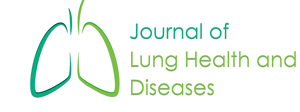Commentary on “COVID-19 pneumonia in the emergency department: correlation of initial chest CT findings with short-term outcome”
Camila Silva Barbosa*, Hye Ju Lee
Radiology Department, Sírio Libanês Hospital, Sao Paulo, Brazil
On October 15th 2020, the Emergency Radiology Journal published our article entitled “COVID-19 pneumonia in the emergency department: correlation of initial chest CT findings with short-term outcome”, that evaluated clinical, laboratorial and imaging findings of laboratory confirmed COVID-19 patients as predictors of severe disease. In this paper, we will explore the context and significance of the early recognition of the disease severity on patients’ management.
DOI: 10.29245/2689-999X/2021/1.1167 View / Download Pdf Exhaled breath condensate: a potential tool to evaluate the relationship between inflammation and dyspnea in patients with chronic obstructive pulmonary disease
Stephanos Patsiris1,2*, Grigoris Stelios2, Ilias Papanikolaou1, Themis Exarchos2, Panayiotis Vlamos2
1General Hospital of Corfu, Corfu, Greece
2Bioinformatics & Human Electrophysiology Laboratory, Dept. of Informatics, Ionian University, Corfu, Greece
Chronic obstructive pulmonary disease (COPD) is a respiratory disease with high prevalence. Many factors contribute to its development, and probably that leads to its various clinical pictures. Inflammation is the mechanism responsible for the structural alterations in the lungs. Despite its heterogeneity, there are a couple of primary symptoms characterizing it, which are chronic and productive cough and dyspnea.
The understanding of dyspnea in COPD is based on theories deriving from the interaction of a network formed between the cardiorespiratory and the neuromuscular system and their receptors. Many factors contribute to its occurrence, making it complex and giving it a very subjective character for a person to perceive.
Various methods are used to study COPD. Non-invasive ones seem to attract attention nowadays. One of them is the exhaled breath condensate. It is a biofluid with rich content, which can capture a picture of the pathological processes happening in the lungs. Its study has shown that some markers of inflammation and oxidative stress, such as 8-isoprostane and H2O2, are elevated and able to connect dyspnea and inflammation. Additionally, they seem to provide information of the ongoing inflammatory process in the lungs as well as a picture of the severity of the symptoms. This evidence may enhance the association of dyspnea with dysfunctional breathing.
Despite these interesting findings, further research is necessary both in dyspnea and inflammation in COPD to clarify their mechanisms and connective pathways. The utility of non-invasive techniques such as the exhaled breath condensate could be of significant help, but its establishment in the medical field requires extra studies.
DOI: 10.29245/2689-999X/2021/1.1168 View / Download Pdf Combination of vaping, cannabis and smoking exposure: shorter time to bullous lung disease and pneumothorax
Farhan Ali
PGY 2, Internal medicine resident, North Alabama Medical Center, Florence, Alabama, USA
We present a 25-year-old Hispanic man with left-sided pleuritic chest pain and dyspnea for three days. His Chest radiograph and CTA revealed bilateral apical bullous disease with a 2.5 cm deep left sided pneumothorax. He was managed with 100% oxygen via non-rebreather mask and did not require invasive decompression. Patient reported a one-year history of vaping along with tobacco and cannabis smoking exposure from his late teen years. The pneumothorax improved and he was discharged to the pulmonary clinic. The authors review the multiplicative effect of vaping on smoking cannabis and tobacco leading to early apical bullous lung disease. Patients with such significant smoking/vaping history may benefit from prolonged pulmonary and addiction medicine follow-up given the clinical bullous lung disease and risk for continued smoking/vaping. The case emphasizes the potential exponential effect of combining vaping with tobacco and marijuana smoke on lung health leading to disease at extremely young ages.
DOI: 10.29245/2689-999X/2021/1.1169 View / Download Pdf